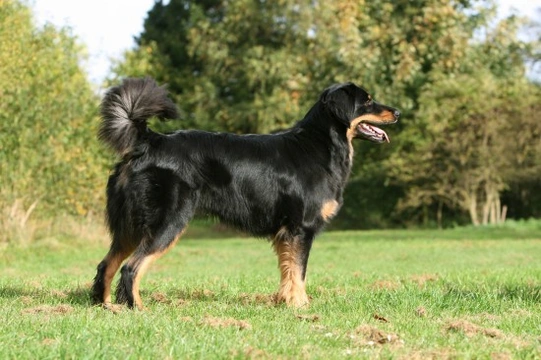
Hovawart dog hereditary health and longevity
The Hovawart dog is a German breed of dog that is medium to large in size, which was originally developed as an estate guarding dog. The name of the breed itself actually translates to “estate guarding dog” in the original German. The breed originates from the Black Forest region, and has a known history in the area going back to at least medieval times.
Hovawarts are medium to large in size, with males standing up to 29” tall at the withers, and up to 26” for females. They can weigh up to 50kg at the top end of the spectrum. The breed can be seen in three different colour variants, being black and gold, all black, or blonde.
The Hovawart is renowned for their prowess as watchdogs, and are loving, devoted and protective family dogs that are known for being somewhat reserved around people that they do not know. Historically used for working roles only, today the Hovawart is becoming more and more popular as a family pet. They require clear direction, lots of early socialisation and good training in order to make the transition to domestic life comfortably, and are not usually considered to be a good choice of dog for the first time dog owner.
If you are wondering if the Hovawart is the right choice of dog for you, it is important to research the core traits of the breed before making a purchase, and also find out what you can about the breed’s average lifespan and general health. We will look at these factors in more detail in this article.
Hovawart dog longevity
The average lifespan of the Hovawart is between 10-14 years, which provides quite a range of variance. At the lower end of the scale, hereditary health issues play some part in the earlier deaths of dogs of the breed, but aside from this, the breed is considered to be generally healthy and can often live towards the top end of the average for all breeds of a similar size.
Genetic diversity
The Hovawart dog is considered to be one of the most genetically diverse of all dog breeds, with the coefficient of inbreeding statistic for the breed across the board being zero. This indicates that the breed is not at risk of any of the various health issues that can accompany inbreeding, and that inbreeding is not considered to be a negative factor in the overall health of the breed.
Few other pedigree breeds have a coefficient of inbreeding statistic of zero, and in fact, the accepted figure for pedigree breeds as a whole is 6.25% or lower.
Heath testing for the Hovawart dog
While the Hovawart dog is widely considered to be a genetically diverse dog that is not at a high risk of inheriting hereditary health defects, like all pedigree dogs, a couple of conditions are known to be somewhat prevalent within the Hovawart breed as a whole.
The British Veterinary Association recommends that dogs of the breed be hip scored prior to breeding, in order to ensure that the breed produces dogs with healthy hips in perpetuity, which are not prone to developing hip dysplasia.
The mean hip score across the Hovawart breed as a whole is nine, and breeders of Hovawart dogs are advised to breed only parent dogs that attain a hip score below this figure.
Hovawart breed clubs also collate data on the thyroid health of the breed, and advise that dogs of the breed be tested for healthy thyroid function.
Other health issues
There are also various other hereditary health conditions that are known to affect some dogs of the Hovawart breed, but for which no pre-breeding health schemes are currently in place. These conditions include:
- A propensity to developing bloat, which may be accompanied by torsion of the stomach. This condition tends to affect dogs that have a deep chest, such as the Hovawart, and is acute in onset and requires urgent veterinary treatment.
- Hypothyroidism also tends to affect dogs of the breed, a condition that causes an underproduction of the necessary thyroid hormones. This condition can often be managed with hormone therapy.
- Dilated cardiomyopathy, a heart condition has also been reported within the breed, a condition that leads to the valves of the heart being defective. However, this condition is not considered to be prevalent across the Hovawart breed as a whole.
- Osteochondritis dissecans is another condition that is recognised within the breed, but again, which is not particularly common. This condition affects the cartilage of the shoulders and the front legs, and may lead to lameness and the onset of arthritis.
- Dogs of the breed should also be properly socialised with other dogs from a young age, as otherwise the breed may have a slight tendency to being aggressive and defensive towards other dogs.



